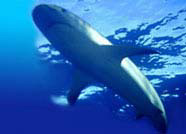


Salmon shark

 |
 |
 |
|||
| Home | Evolution
| Classification
| Glossary | Biology
| Behavior | Shark
Repellent | Shark
Conservation | Do's &
Don'ts | Did You Know?
Salmon shark |
 |
||||
|
 Scientific
Name: Lamna ditropis Scientific
Name: Lamna ditropisClosely related to great whites, salmon sharks, as their name suggests, feed on salmon. Functionally warm-blooded, they have streamlined bodies and are capable of great speed. They are also called as Pacific Poarbeagle. The skin is dusky gray above and paler below with white markings. A strong swimmer, it has a wide tail that has a double keel (a second, short ridge running along the upper part of the lower lobe of the tail). A double keel is unusual among sharks; the only other double-keeled tail is on the closely related Porbeagle Shark, Lamna nasus. These large, powerful, warm-bodied and streamlined predators are well adapted for high-speed swimming. Salmon sharks have large teeth and long gill slits. These sharks are functionally warm-blooded, an adaptation that enables them to inhabit sub-arctic waters. It is estimated that they can live up to 25 years. Salmon Sharks are large, powerful, warm-bodied and streamlined predators are well adapted for high-speed swimming. This shark is found in the Bering Sea and off western North America. It lives from the surface down to moderate depths. They occur in the northern Pacific and are common in Alaskan waters, where their numbers seem to be increasing. They inhabit coastal and oceanic waters to depths of 150m (490ft). Salmon sharks are voracious feeders, particularly on salmon, from which they get their name. They also eat many other fish and marine creatures. The sharks congregate off southeast Alaska in late summer where they eat salmon that are trapped there until rain swells the rivers. They are found singly and in schools or feeding groups. The salmon shark is ovoviviparous - it produces eggs that hatch within the female's body. They bear live young and may have up to five pups per year. Gestation is around nine months They are considered a pest to fishermen as they cause damage nets and steal fish. They are fished for their meat, but not thought to be threatened. Statistics: Average size range appears to be between 2-3m (6.5-9.5ft), but the largest-known Salmon Shark was 10-ft (3 m) long. Salmon Shark Classification:
|
|||||
| Sitemap | Reach To Us | Jimtrade - Business Directory of India | |||||